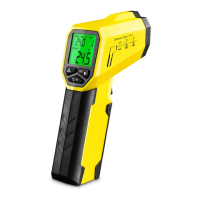4 EN
pyrometer BP17
Warning
Dangers can occur at the device when it is used by
untrained people in an unprofessional or improper way!
Observe the personnel qualifications!
Caution
Keep a sufficient distance from heat sources.
Note
To prevent damages to the device, do not expose it to
extreme temperatures, extreme humidity or moisture.
Note
Do not use abrasive cleaners or solvents to clean the
device.
Information about the device
Device description
The pyrometerBP17 uses an infrared sensor to measure
surface temperatures without contact. An integrated laser
pointer serves for the determination of the measuring spot.
For temperature measurements sensitivity levels of 1°C, 3°C
and 5°C can be preselected– depending on a reference
temperature. Exceeding or falling below this preselected
threshold is indicated by an acoustic and visual alarm function.
The display is automatically illuminated during a measurement.
An automatic switch-off saves the battery.
Measurement principle
The device measures the temperature by means of an infrared
sensor. Important factors playing a role in the temperature
measurement are the measuring spot diameter and the degree
of emission.
Measuring spot
Observe the ratio of the distance to the measuring spot
diameter. The larger the distance to the object, the larger the
measuring spot diameter and hence, the less precise the
measured result. The connectable laser pointer indicates the
approximate measuring spot centre. Consequently, it is a mere
aiming aid and not intended for the actual temperature
measurement.
Degree of emission
The degree of emission is used to describe the energy radiation
characteristics of a material.
Most organic materials have an emissivity of0.95. Metals or
shiny materials come with a much lower value.
A material's emissivity depends on various factors, e.g. on
• Material composition
• Surface condition
• Temperature
The emissivity can range between 0.1 and 1 (in theory).
The following rule of thumb can be assumed:
• When a material is rather dark and its surface texture matt,
it probably has a high emissivity.
• The brighter and smoother the surface of a material, the
lower will be its emissivity, presumably.
• The higher the degree of emission of the surface to be
measured, the better it is suited for non-contact
temperature measurement by use of a pyrometer or
thermal imaging camera, since falsifying temperature
reflections become negligible.
Emissivity table
The following table supplies reference values for the degree of
emission of common materials and merely serves for orientation
purposes. The degree of emission is fixed to0.95 on the
measuring device.
Material Degree of emission
Aluminium, roughened 0.1 to 0.3
Aluminium, alloy A3003,
oxidized
0.3
Aluminium, oxidized 0.2 to 0.4
Asbestos 0.92 to 0.95
Tarmac 0.92 to 0.95
Basalt 0.7
Concrete 0.92 to 0.95
Bitumen 0.98 to 1.00
Lead, oxidized 0.2 to 0.6
Lead, rough 0.4
Roofing felt 0.95
Ice 0.98
Iron (forged), blunt 0.9
Iron, oxidized 0.5 to 0.9
Iron, rusted 0.5 to 0.7
Enamel varnish, black 0.95
Earth 0.92 to 0.96
Paint (not alkaline) 0.90 to 0.95
Paint (non-metal) 0.95

